|
Location: Israel. |
Grid Reference: 31�
47' N, 35� 13' E |
 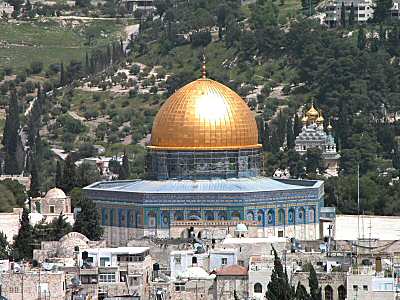 Israel:
Israel:
Jerusalem
is one of the holiest places on the planet. It is an 'Earth-Navel', and
is considered sacred ground to the Muslims, Jews, and Christians alike.
This has turned it into a city of turmoil for its entire history, being
taken and retaken over and again by waves of conquering Christian,
Jewish and Muslim armies all fighting for the same spot of ground.
The dome of the rock,
on Temple mount is said to have held great treasures which the Knights
Templar are rumoured to have discovered during their short stay on the
mount.
The Temple Mount is
supported by several immense foundation stones, regularly estimated to
weigh 500 tons.
(Click here for 1886 Ordinance Survey of
Jerusalem)
Article:
Statesman.com (May, 2013)
'Massive Underwater Structure Baffles
Archaeologists'
'A Massive
circular monument was recently discovered beneath the Sea of
Gallilee. It's thousands of years old - A conical, manmade
structure weighing hundreds of tons. The monumental structure,
made of boulders and stones with a diameter of 70m (230ft),
emerged from a routine sonar scan in 2003. Researchers at the
University of Haifa have been reported as saying "We only know
it is there, it is huge and it is unusual".
(Link
to Article)
|
Jerusalem - 'Jeru - Shalom': |
Description:
The site where Abraham prepared to
sacrifice his son, King Solomon was commanded to build the first
temple by god, and the place where the Prophet Mohammed 's
ascension occurred into paradise on his celebrated 'Night
journey'. (12).
Despite having an area of less than
one square kilometer, the old city is home to sites of key religious
importance, among them the Temple Mount, the Western Wall, the Church of
the Holy Sepulchre, the Dome of the Rock and al-Aqsa Mosque. It is the
holiest city in Judaism, the third holiest in Islam and one of the
holiest in Christiandom.
Temple
of the Mount: The Foundation Stones.
Several
massive stones
'under-pin' the Temple mount. They are estimated to weigh around
500 tons each. They were found when excavations along the western 'Wailing wall'
uncovered them.
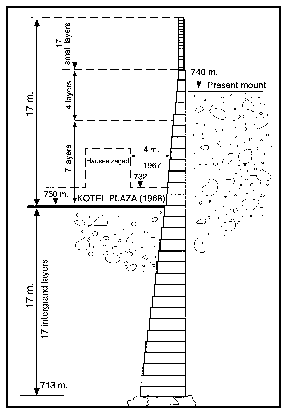
There are only three examples of masonry similar to this; In
Jerusalem, at nearby Baalbek in
Lebanon, and at Giza, Egypt.
The following extract
(from Miracle of Ages), adequately describes the now famous conversation
between Herodotus and Manetho:
'In the course of his questioning he
(Herodotus) encountered one Manetho, an Egyptian High Priest, scholar
and Historian, with whom he conversed at length thru the agency of an
interpreter. Manetho informed his distinguished guest that the architect
of the huge mass of stone was one "Philition", or "Suphis", of a people
known as the "Hyksos", that is "Shepherd Kings". According to Manetho,
the Shepherd Kings were "a people of ignoble race" who came from some
unknown land in the
East; they were a nomadic band who
numbered not less than 280,000 souls; they brought with them their
families and all mobile possessions, including vast flocks of sheep and
herds of cattle; and they "had the confidence to invade Egypt, and
subdued it without a battle". this same people, said Manetho, overthrew
the then-reigning Dynasty, stamped out idolatry and endeavoured to
firmly establish in the place thereof the worship of the One true God
having completed the Great pyramid, migrated eastward into the land
afterwards known as Judea and founded there the city of Salem, which
later became Jerusalem, the Holy city.'
(6) (It is noted that although Manetho is a proud Egyptian, he still
stated that the pyramids were built by foreigners).
The following
extract is from Rawlinson's 'Phoenecia' concerning the
architecture of Jerusalem.
'The wall had an original height of from
seventy to one hundred and fourty feet. In places it is built from
bottom to top of large squared stones, bevelled at the edges and
varying between 3 ft 3 inches and 6 ft in height. The stones are laid
without cement. The longest hitherto discovered measures 38 ft 9
inches in length (not less than one hundred tonnes). Many of the other
blocks are from half to two thirds of this height.
The massiveness
of the work is on par with the Egyptian pyramid-Kings; and the
perfection of the cutting and fitting of the stones is nearly equal.'
(2)
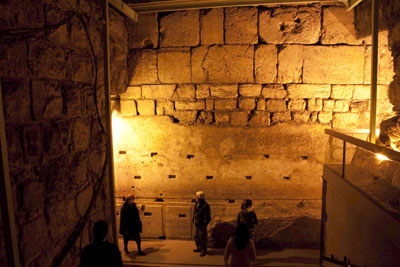
It is noticeable from the photo
(left) that the stones of the Wailing Wall get larger towards the
bottom (except for the courses directly above the largest foundation
stones). However, at the very bottom, well below the current street
level, and holding the whole western side of the Temple mount, the
stones are of a distinctly different style, having been carved perfectly
square, and in a disproportionate scale to the rest of the blocks used
above. They would have had to have been dragged uphill in order to
position them and are believed to have been the original foundation
stones of the first temple.
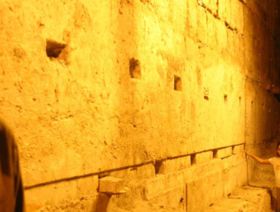
1 Kings 13-17:
13 And king Solomon
chose workmen out of all Israel, and the levy was of thirty thousand men.
14 And he
sent them to Libanus, ten thousand every month, by turns, so that two
months they were at home: and Adoniram was over this levy.
15 And Soloman had seventy
thousand to carry burdens, and eighty thousand to hew stones in the
mountain:
16 Besides the overseers who were
over every work, in number three thousand and three hundred, that ruled
over the people, and them that did the work.
17 And the king commanded that
they should bring great stones, costly stones, for the foundation of the
temple, and should square them:
18 And the masons of Solomon and
the masons of Hiram, hewed them: and the Giblians prepared timber and
stones to build the house.
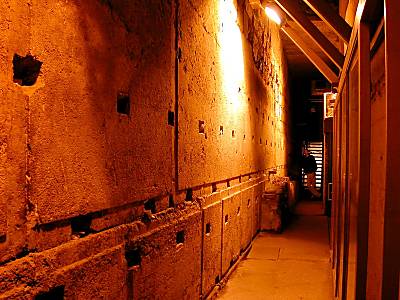
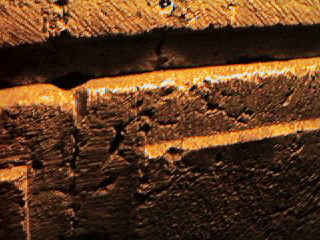
A close-up of the massive
blocks.. with embossed edges.
(The
Top-50 Megaliths of all Time)
The Dome of the Rock
The most contested part of Jerusalem, and currently under Muslim
control.
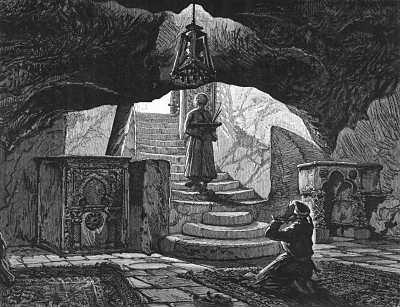
'Beneath
the rock there is a small cave . . . the entrance to which is at the
south-east corner of the rock; a flight of steps passes under an archway
and leads down to the chamber. The average height of the cave is six
feet. In the roof is a circular opening which pierces the rock; the
floor is paved with marble, and the sides are covered with plaster and
whitewash. The floor, when stamped upon, gives out a hollow sound,
indicating the presence of a lower chamber, possibly a well, the "Well
of Spirits." The sides, too, when tapped give forth a hollow sound,
which the Moslem guardian brings forward as a proof that the Sakhra is,
in accordance with the legend, suspended in the air. (Source:
Picturesque Palestine, vol. 1, pp.
61-62.)
The church of the Holy Sepulchre
- Outside the old city a church marks the spot where Joseph of Arimathea
buried Jesus in his tomb. When Emperor Hadrian raised Jerusalem in the 2nd
Century AD, he built a temple to Venus on the site. Following a
division made in 1757 by the ruling Turks, the holy place is shared by
Greek orthodox, Roman Catholic, Armenian, Syrian and Coptic
churches.
(12)
|
Jerusalem: The origin of the name.
The Semitic root of the name was
sometimes thought to be "s-l-m" meaning peace, harmony or
completeness. A city called Ru�alimum or Uru�alimum
appears in ancient Egyptian records as one of the first reference to
Jerusalem. (17) These Egyptian forms are thought to derive from the
local name attested in the Amarna letters, eg in EA 287 (where it
takes several forms) Urusalim. The form Yerushalayim
(Jerusalem) first appears in the book of Joshua. |
Article: National Geographic
Article (Nov 2008):

'Archaeologists in northern
Israel say they have discovered the world's oldest known grave of a
shaman. The 12,000-year-old grave holds an elderly female of the
mysterious Natufian culture, animal parts, and a human foot. Hundreds
of Natufian graves have been excavated in Israel, Jordan, Syria, and
Lebanon. But only the one uncovered by Grosman contains a woman
believed to have been a shaman.
The 1.5-meter-tall (nearly 5-foot-tall),
45-year-old woman was relatively old for her time. After her death,
she was placed in a mud-plastered and rock-lined pit in a cave and was
buried beneath a large stone slab. She was not
buried with everyday items and tools, as hunters, warriors, or
political leaders were. Instead, her grave contained 50 arranged
turtle shells and parts of wild pigs, eagles, cows, leopards, martens,
and a human foot'.
(More about Shamanism)
(Click here for full article)
|
Chronology of Jerusalem:
Ceramic evidence indicates the
occupation of Ophel, within present-day Jerusalem, as far back as
the Copper Age, c. 4th millennium BCE, (5), (4), with evidence
of a permanent settlement during the early Bronze Age, c.
3000-2800 BCE.
(3)
597 BC
- The Babylonian king Nebuchadnezzar seizes Jerusalem.
(11).
589 BC
- Pro-Egyptian rebellion lasts 2� years.
(11).
586 BC
- The city falls again to the Babylonians. This time the temple and
Jerusalem are totally destroyed.
(11).
539 BC
- The Persian king Cyrus takes Babylon, Hebrews are allowed to
return with the treasures that Nebuchadnezzar took.
(11)
537 BC - Cyrus the Great conquers Babylon
and permits the Jews to return.
- Temple rebuilt before end of 6th century
by Zerubbabel.
(11).
- Persia holds the city until 333 BC when
Alexander the Great takes Palestine.
198 BC - The Seleucid king Antiochus II
conquers Judea, making it tributary of Syria.
- Jews later revolt under the leadership of
Maccabeans and defeat the Syrians.
165 BC - Temple re-consecrated.
63 BC - Rome takes the city.
40 BC - Reign of Herod. Second temple built.
67 AD
- The Nazoreans or 'Zealots' take Jerusalem and the Temple
(11).
70 AD
- The city falls to the Romans. Temple destroyed. (11). Temple to
Jupiter erected.
(10).
2nd Century AD
- Emperor Hadrian raises Jerusalem
(12).
325 AD
- Jerusalem experiences 300 years of Christian domination. Jews and
Muslims barred
(12).
691 AD
- Muslims conquer city, The Caliph of Damascus 'Abd al-Malik',
builds the 'Dome of the rock' mosque, and covers it with gold
mosaics, the Ottoman Turks later replaced these with 45,000 tiles.
The Dome today is covered with gold-plated aluminium embellishes
with verses from the Koran
(12).
14th June 1099 AD
- The Crusders, led by Godfrey de Boullon, capture the city
following Pope Urban's call in 1096. The
Templars excavate the ruins of Herod's temple in Jerusalem. The
Qumran scrolls (Dead Sea scrolls), tell how the community hid its
wealth under the Temple
(11).
Baldwin I declared king of Jerusalem.
1187 AD - Saladin recaptures the city for the Muslims and the
Ayyubid and Mameluke dynasties ruled until 1517 when the Ottoman empire
took over. 1917 AD - British occupy Jerusalem,
becomes the capital of mandated Palestine from 1923 to 1948.
1949 AD - United Nations partition plan
rejected and city divided into Israeli and Jordanian sectors.
1967 AD - Six day war. Israel takes the entire city. |
The knight's Templar and Jerusalem.
The Knights Templar history starts in the year 1119
in Jerusalem. The order take their name from Solomon's temple. Their
official purpose was to protect the roads for pilgrims to the city, but
as there are so few records of events and the fact that we know that
there were only nine in residence at Jerusalem it is suspected that
there was another agenda afoot.
The recorded actions of the knights suggests that
they spent nine years digging and excavating a series of tunnels under
their quarters on the temple mount. These tunnels were re-excavated in
1867 by Lieutenant Warren of the Royal Engineers. The access tunnel
descends vertically downwards for eighty feet through solid rock before
radiating in a series of tunnels horizontally under the site of the
temple itself. In the tunnels he found a spur, remnants of a lance, a
small Templar cross and the major part of a Templar sword. These
artefacts are now preserved by Templar archivist for Scotland, Robert
Bryan of Edinburgh.
(7)
The discovery of the Dead Sea Scrolls, in particular
the Copper scroll, which is an itinerary of treasures supports the idea
that they were searching for the lost wealth of the Hebrews. Of great
interest then is the fact that they soon became an enormously wealthy
group, influencing Popes, Kings and European politics. They accumulated
great wealth and power with banking activities, lending money to the
European kings. The Templars prosperous business turned into their ruin
when Philip the Fair of France, unable to repay his enormous debt with
them, decided to wipe out the order all together. He also convinced the
Pope Clemente V to accuse the Templar's of heresy and to confiscate all
their properties. The knights were persecuted, killed and tortured and
in few years the order was completely annihilated. It is often claimed
that King Philip of France secretly ordered the mass arrest of all the
Knights Templar in France on Friday, October 13, 1307.
(8)
(View a map of the underground features on
the 'Temple Mount')
|
Jerusalem as an Earth
Navel.
Jerusalem is considered a 'Earth
navel' by Christians, Jews and
Muslims alike.
(10).
"This city of Jerusalem I have set among the
nations, with the other countries around about her" (Ezek. 5:5)
Although Jerusalem shows as the centre of many
Mappaemundi, the practice of placing Jerusalem at the centre was
largely confined to the post-crusade period in the thirteenth and
fourteenth centuries. Other references to Jerusalem are also largely
from Christian sources, such as:
'Adamann, abbot of Iona, in his De Locis Sanctis,
speaks of: "a very high column which stands in the centre of the city...
It is remarkable how this column... fails to cast a shadow at midday
during the summer solstice, when the sun reaches the centre of the
heavens... And so this column... proves Jerusalem to be at the centre of
the world... and its navel'.
(1)
Note: Although such an observation of the sun is
impossible astronomically (unless the column was leaning at ten degrees
towards the south), it is clear that an attempt was being made to
combine science with religion., as is the following extract from one
'Bernard the Wise' (c. 870 AD), who reported that:
'The walls of the four main churches in Jerusalem
enclosed an un-roofed porch, over which four chains were strung from
each church to join in a point over the centre of the world'.
(1)
(More about Earth Navel's) |
Alignments - Solomon�s
temple was orientated due east, so that the dawn-light would have
entered the Tabernacle at both the spring and autumn equinoxes.
Commenting on
the autumn equinox Lady Flavia says: �In Jerusalem the solar orb would
on this day rise directly over and appear to rest on the Mount of
Olives. John Michell and Christine Rhone, in their work Twelve Tribe
Nations and the Science of Enchanting the Landscape (1991) remark:
��.the �Messianic ley� from the Mount of Olives and along the Temple
axis points directly to the most sacred rock of Christendom, the hill of
Golgotha or Calvary whereon Jesus was crucified. Golgotha is a natural
rock pinnacle, a miniature sacred mountain, which in the time of Jesus
stood just outside the city walls. There is archaeological evidence that
it was once a place of pagan worship. It is traditionally claimed that
Adam�s skull is buried beneath it, and this contributes to its Christian
reputation as the symbolic earth navel.�
Gallery of Images:
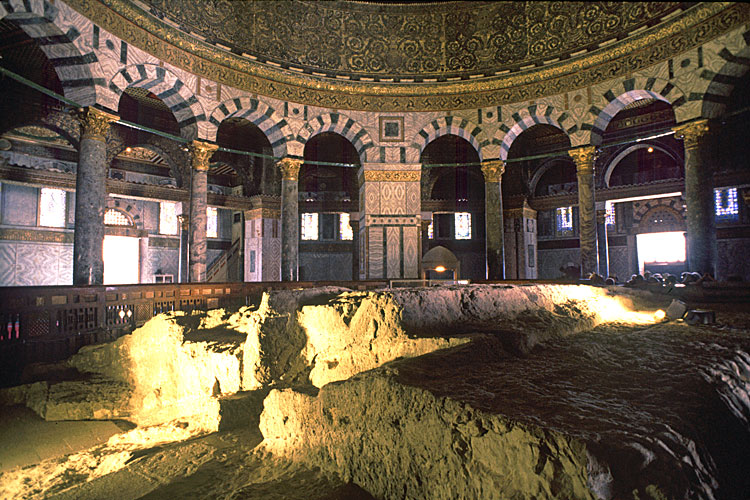
The Dome of the Rock - Interior..
(Oracle
Centres)
(Earth
Navels)
(The
Top-50 Megaliths of All Time)
(Additional
Information about Jerusalem at SacredSites.com)
|








